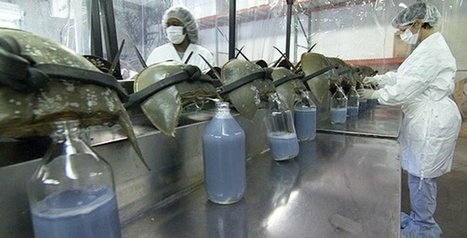Each year, half a million horseshoe crabs are captured and bled alive to create an unparalleled biomedical technology.
The thing about the blood that everyone notices first: It's blue, baby blue.
The marvelous thing about horseshoe crab blood, though, isn't the color. It's a chemical found only in the amoebocytes of its blood cells that can detect mere traces of bacterial presence and trap them in inescapable clots.
To take advantage of this biological idiosyncrasy, pharmaceutical companies burst the cells that contain the chemical, called coagulogen. Then, they can use the coagulogen to detect contamination in any solution that might come into contact with blood. If there are dangerous bacterial endotoxins in the liquid—even at a concentration of one part per trillion—the horseshoe crab blood extract will go to work, turning the solution into what scientist Fred Bang, who co-discovered the substance, called a "gel."
"This gel immobilized the bacteria but did not kill them," Bang wrote in the 1956 paper announcing the substance. "The gel or clot was stable and tough and remained so for several weeks at room temperature."
If there is no bacterial contamination, then the coagulation does not occur, and the solution can be considered free of bacteria. It's a simple, nearly instantaneous test that goes by the name of the LAL, or Limulus amebocyte lysate, test (after the species name of the crab, Limulus polyphemus).
The LAL test replaced the rather horrifying prospect of possibly contaminated substances being tested on "large colonies of rabbits." Pharma companies didn't like the rabbit process, either, because it was slow and expensive.



 Your new post is loading...
Your new post is loading...








Amazing article about the recent, industrial history of a 500 million years old animal, that has been exploited massively and for different purposes across the past decades, including in very high end biomedical technology. And if you read it until the end, you'll know why Limulus blood is blue...